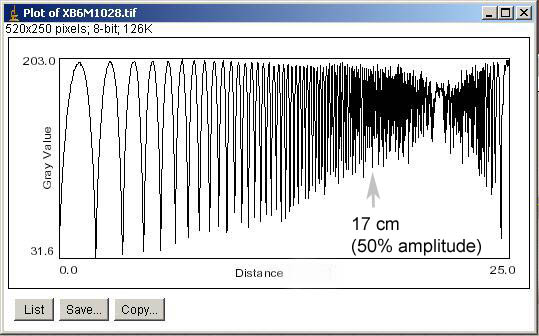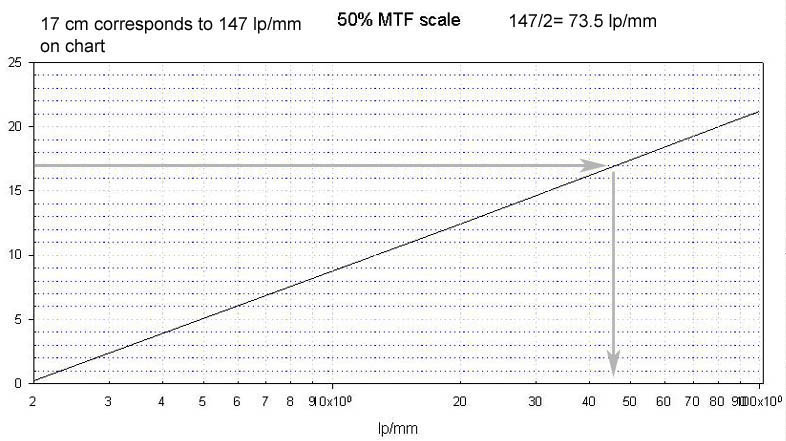Methods for Measuring 50% MTF and
Contrast at 10 lpm
50% MTF (modulation transfer
function):
Tests were run at 87 inches from the target. An
Edmund Scientific lens
resolution chart was illuminated with a monolight flash modeling
lights. The camera and lenses were mounted on a Bogen 3033/Arca Swiss B1
tripod/head combination similar to the resolution tests.
There is general agreement that perceived image sharpness is more
closely related to the spatial frequency (lp/mm) where MTF is 50% (i.e.,
where contrast has dropped by half) than to resolution alone. I used the
Koren 2003 lens test chart
developed
and explained by Norman Koren to calculate 50% MTF. Printed test
charts were placed on the Edmund Scientific Test Chart as in the middle
and edge of the chart as shown
here. The chart was photographed under tungsten bulb lighting. A
Canon EOS-1Ds Mark II was set at ISO 100, tungsten bulb white balance and
shot with + 1.3 EV using evaluative metering with the camera set for
mirror lockup. Raw files were converted to 300 dpi tifs with Capture One
Pro v. 3.7.3. Measures of 50% MTF were calculated using the central chart
and edge chart. Calculated values were center weighted (70% center; 30%
edge.) and also plotted for center and edge values alone.
The imaged sine patterns were analyzed withand measurements were made on
the resulting Plot Profile to determine line pair per mm frequency of 50%
contrast as explained in detail on the Norman Koren website.
Details of calculating 50% MTF:
1. The 5mm Koren 2003 lens test chart designed to be printed at 25 cm
long (50X magnification) was downloaded from the Koren website and printed
on semi-gloss paper with a Epson 1270 printer at 1440 dpi. Charts are
trimmed and mounted on the Edmund Scientific Test Chart as shown:

2.
The chart is photographed at a working distance that is 1/2 the
recommended distance so that the entire Edmund Scientific chart can be
photographed for resolution and determination of 50% MTF. It is also
possible to detect lateral chromatic and other aberrations from the same
test images. The distance from the chart was calculated at d1=(M+1)f
where d1 = lens to target distance (mm) and f = lens
focal length (mm) and M=25. The reduction of distance by 1/2 requires that
lp/mm figures read off the chart be adjusted by 1/2.
3.
Photographic RAW files are converted to tifs with Capture One Pro. The tif
files are opened in image analysis software to analyze the sine patterns
on the chart (top band). I used
ImageJ
software, public domain software off the NIH site.

Click on "File" and then "Open" to select and open the
tif of interest.
4. Click on the "magnifying cursor symbol"
to fill the window with the Koren chart image and click on the "hand"
icon to move the chart image into the middle of the window.
5.
Click on the line icon and draw a straight line through the upper sine
pattern bar on the Koren chart.

6.
Click on the "Analyze" menu and select "set scale" and
enter "known distance" as "25" and "units"
as "cm".
7. Click on "Analyze" again and
select "Plot Profile."
8. A sine wave pattern will be
generated and displayed.

9.
The full amplitude of the sine wave on my computer screen has a 7 cm
sweep. I just take a rule and run it down the plot towards 25cm until the
amplitude is 50% (3.5 cm). In the example, 50% amplitude is at 17 cm on
the chart. This corresponds on a plot of cm of chart versus a log plot of
spatial frequency below to 147 lp/mm.

10.
Because the working distance was decreased by 1/2 when photographing the
chart, the lp/mm value is divided by 2 to generate the 50% MTF value.
Because 50% MTF has been calculated by evolving methods throughout the
series of lens reviews, results from one review cannot be compared
directly with those of another review. Comparisons can only be made within
the same review.
Details of calculating contrast
at 10 lpm
Contrast is calculated as the ratio of sine wave amplitude at 12.5cm on
the plot compared to maximum sine wave amplitude in the plot. The point of
12.5 cm on the plot corresponds to 20 lp/mm on the Koren chart. Again,
because meaurements are being made at 1/2 the regular working distance
from the camera lens to the chart, this is actually the ratio of the sine
wave amplitude to maximum at 10 lp/mm. Calculated values were center
weighted (70% center; 30% edge.) and also plotted as center and edge
values.




